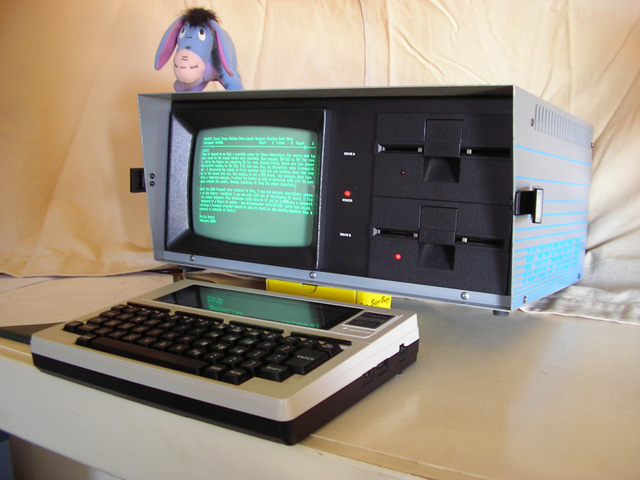A TRS-80 Model 100 as a Kaypro II Keyboard
 Recently a fellow vintage computer enthusiast Philip Avery (see opposite) acquired a Kaypro II.
Recently a fellow vintage computer enthusiast Philip Avery (see opposite) acquired a Kaypro II.
Philip had a few issues with the machine, most of which he fixed quickly. The keyboard proved faulty though.
Detailed below is Philip's innovative temporary solution, written in his own words. This may help those readers who have a similar issue. The technique could be adapted for any vintage computer with a RS 232 port and whose keyboard uses a simple serial interface.
Tez
Being the proud new owner of a Kaypro II, I was anxious to get it up & running. When its keyboard developed a fault within minutes of power-up, I began to consider alternatives for the Kaypro keyboard, while I undertook troubleshooting. I have a few Radio Shack TRS-80 Model 100s and Model 102s around - ideal if I could hook one of those into the Kaypro.
Discussion on the Vintage Computer Forum concluded that this should be possible, even revealing the settings required for the serial keyboard (300 baud, 8 bits, 1 stop bit, no parity).
I began by merely connecting Ground from the M100 RS-232 cable to the Kaypro, and Transmit data (pin 3, because my cable is a null-modem type) into the buffer for the keyboard SIO (see below). Whilst this didn’t work, I discovered by jumping (& disabling) the first inverter – I was able to get typed characters onto the Kaypro.

Figure 1. Keyboard and RS-232 I/O Schematic
Enter “dave_m” of the VC Forum. On reading this, he alerted me to the proper approach. His suggestion was to plug the null-modem cable into the RS-232 port of the Kaypro and merely link the output of the driver (U69, pin 3) to the SIO keyboard input buffer(U71, pin 13). He so rightly stated:
“I think you were lucky that the Model 100 does not have true RS-232 drive levels of about +/- 10V. That would not have been good for the TTL gate in the Kaypro. From what I can tell, the Model 100 has a simple driver with about +/- 3V so your Kaypro is apparently surviving OK with it although it explains why you had to invert the signal since you do not have a RS-232 receiver on the kaypro keyboard interface.”
I made the changes, and it works perfectly. Furthermore, any RS-232 device can safely use Dave’s approach and it is considerably more elegent mechanically – my previous approach meant I had to hack into the null-modem cable & pass wires through ventilation slots of the Kaypro!

Photo 2. TRS-80 Model 100 acting as a keyboard for Kaypro II. (Note, this article was initially typed on the Kaypro!)
This substitution could also be of use in isolating a suspect keyboard of a Kaypro II system - any microcomputer with RS-232 (with the right settings & terminal program) should be able to stand in and verify whether the keyboard is actually at fault.
Philip Avery
Original: 19th February 2010
Revised: 24th February, 2010
| Tweet |